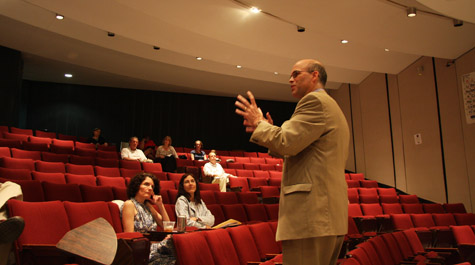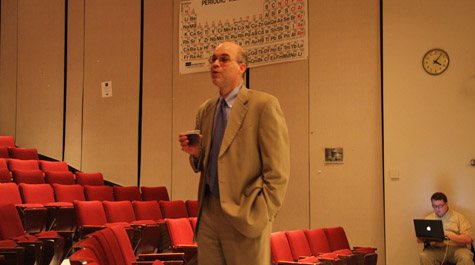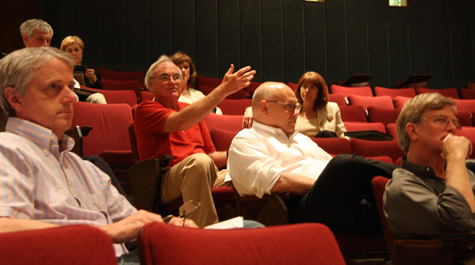Final campus conversation addresses 'white paper'
"We have a distinctive quality and we need to retain it: high quality faculty, deep commitment to learning and the advantages of a relatively intimately sized operation," Halleran said. "What we need to do is take advantage of these particular strengths and build on them."
Halleran wrapped up the yearlong discussion April 8 with a session about the draft "white paper" document that both describes the findings from the six previous conversation sessions and makes recommendations on how the College should move forward.
"It's not a summary," said Halleran, noting that the previous six public forums included faculty panels, a student-led panel and distinguished guest speakers. "It really is more a distillation, so taking what is addressed and spoken about and kicked around and sometimes argued in those six sessions as well as in many, many others - in everything from lunches to faculty meetings to e-exchanges."
The paper, Halleran said, attempts to do three things: address what William & Mary is as a liberal arts university, define what challenges the College faces and what advantages it has going forward and serve as a guide for next year's curriculum review and the revisiting of the merit system.
"One thing that has come up in many of the discussions is that if we say we value A, B and C, and our merit system does not reward A, B and C, we have a fundamental disconnect so how do we sync those," said Halleran.
Halleran said there was consensus that the term liberal arts university is not "the most felicitous phrase on the planet"; however, it is not a bad way to describe the College because of its unique qualities.
"We are this hybrid. We have an intense, very strong focus on undergraduate education and the liberal arts, but that's not all we do," said Halleran.
The provost added that the draft report, which is posted on the conversation Web site, also addresses the fact that money has to be a factor to keep in mind as the College decides its future.
"I just wanted to remind all of us that we live in a world which has constraints, not that we were particularly bound by them in our conversations. I was delighted at that," he said. "Anything that we move forward on, that's one variable - it's the not the only variable, it's only one variable - in thinking how we want to chart our course."
Halleran added that though there has been discussion in the media recently about the poor economy killing liberal arts, a William & Mary education will continue to be a valuable asset.
"There is a very strong claim for us that that the kind of education that we offer - both in terms of the subject matter and more so the way we go about getting students to think about the world, with an intensity of experience and commitment to inquiry - that is going to be progressively more valuable in the world," he said.
Following Halleran's comments, several faculty members and an alumna voiced concerns about portions of the report or issues that were not included in the white paper, including the College's commitment to face-to-face teaching, the portion of classes taught by non-tenured or non-tenure track professors and involving faculty in determining factors for admission decisions and formal leadership training at William & Mary.
At the end of the discussion, Halleran noted that as the College moves forward, some things - courses, programs, etc. - may have to be left behind or modified in order to make room for the new.
"We cannot do everything we currently do in the same way that we currently do it and do anything new. We can't. We could do it for a year, maybe two years. But it will not be sustainable," he said. "The more rigidly we define these things that we have to do, the more difficult any kind of change is."
Halleran said he sees embracing change and leaving some things behind as one of the biggest potential "stumbling block" as William & Mary moves forward.
"Those are the kind of things we'll have to accept and embrace or otherwise, if we just add, we'll kill ourselves at some point, which we don't want to do."
To view the draft white paper in its entirety, visit http://www.wm.edu/conversation. Comments may be submitted on the conversation blog at http://conversation.blogs.wm.edu on via Web form at https://forms.wm.edu/159.
 Skip to main content
Skip to main content



